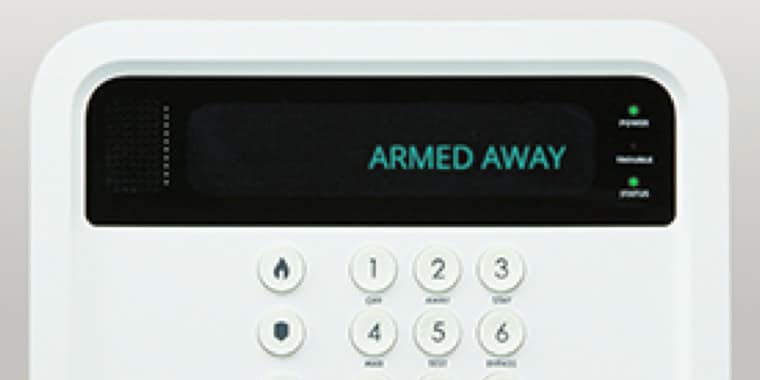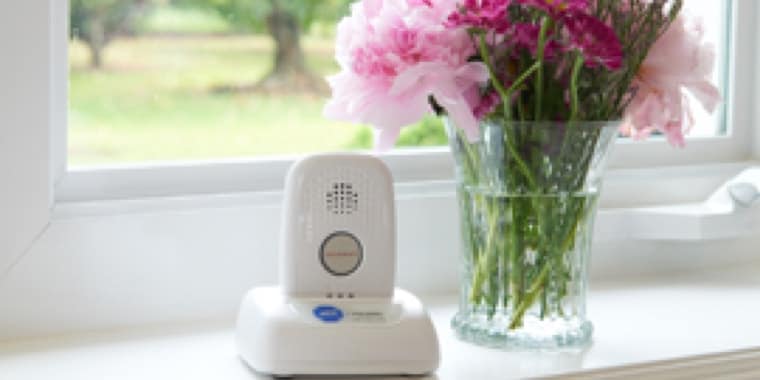Adding smart home automation doesn’t have to cost you a ton of money. In this age, technology evolves so quickly that it can be hard to keep up. We’re here to help.
With that in mind, there are still smart features that are easy to install that may still increase your home’s value, such as a smart, programmable thermostat or video doorbell.
According to Consumer Reports, some people will pay as much as 3 to 5% more for a home with these amenities.
What is a smart home and what are some benefits?
A smart home refers to a residence that utilizes smart technology through appliances or other devices that connect to Wi-Fi. You can use a smartphone, laptop, tablet or computer to access your devices anywhere you have an internet connection.
Connect your stove or refrigerator, locks, lights, thermostats. You can even add your home security system to a central hub or connect it through the cloud. There, you can create schedules that turn things on or off or just take a peek at devices to make sure they’re functioning correctly. With home automation, you can set or monitor your home security system, speak to a guest through a 2-way video doorbell and so much more.
Many intelligent home systems can offer valuable insights to help you manage your energy, creating an energy-efficient plan that reduces consumption and overall costs for you.
Smart home automation stats and facts:
The people have spoken, and they are often willing to pay more for pre-installed smart home features. As many as 77% of people surveyed in a Coldwell Banker survey admitted they would want an intelligent thermostat already installed in their new home.
Smart home automation is a wise investment, whether you’re looking to upgrade a home security system or you want to add smart devices to save on energy bills.
Almost 2/3 of respondents said they think the average ROI of smart appliances will be more than 11% over regular home appliances [3].
An estimated 94 million homes own a smart speaker.
62% of people Lowe’s surveyed rank home security and monitoring high on their reasons to own a smart home [6].
Smart thermostats are coveted in smart homes. In fact, 44% of Americans want to adjust their heating and cooling automatically [4].
Apartments with next-generation products make 13.8% more money than apartments without these features [7].
Over 66% of developers and builders say they get higher sales prices on properties if next-gen appliances are installed [7].
16 smart home technology upgrades that increase the value of your home:
The demand for smart home devices is increasing, bringing with it a slew of technology to help make your home more comfortable, energy-efficient and safer. But in a world that is constantly evolving technologically, the systems we use today may seem outdated almost as soon as we install them.
Many people install smart home devices to make things more convenient in their daily lives. But will those smart devices translate to a higher sticker price for your home, too?
These days, it’s not just a gleaming kitchen that homebuyers are looking for, but also state-of-the-art smart devices too. Both smart home features and energy-efficient features were considered for homebuyers [2].
So, do smart homes add value and sell faster?
There is some discussion that these types of upgrades can add up to 11% more to your return on investment (ROI) over standard products according to a 2017 survey [3]. With appliances topping the list at 18.2%, HVAC and utility management (like thermostats) increasing your ROI by 10.1%, and flooring and lighting fixtures at 8.8% [3].
Here is a breakdown of a few smart home technology upgrades you can look into adding to your home today.
Smart smoke and carbon monoxide detectors
Smart speakers
Smart sprinklers
Smart appliances
Smart faucets and showers
Smart shades or shutters
Smart washing machines and dryers
Smart home features that can increase home value
According to a Lowe’s survey, these are the top three smart home features Americans want [4]:
Changing the temperature with a smart thermostat (44%).
Lights you can adjust from your phone (39%).
The ability to start the coffee maker before getting out of bed (27%).
Smart thermostats
These devices make it easy to control your temperature from anywhere. Schedule your smart thermostat to turn off when you leave for work and program it to turn back on when you’re on the way home.
What makes it better than a typical programmable thermostat is that it is more intuitive, learning from how you program it and eventually adjusting the temperature on its own to help save energy costs.
How to use a smart thermostat:
Track your energy usage and see how it changes over time.
If you forgot to adjust the temperature on the way out the door, it’s easy to turn it off or on remotely.
Monitor your HVAC when you’re not home and get alerts if it doesn’t seem to be heating or cooling properly.
Smart smoke and carbon monoxide detectors
Traditionally, you must be nearby to hear a fire alarm go off. But with smart smoke detectors or carbon monoxide sensors, an alert can go directly to your phone or professional monitoring services. These types of sensors notify you directly, but they are often built so they know exactly where the smoke is happening.
How to use smart smoke and carbon monoxide detectors:
If you have an integrated smart home security system in place, you can shut down your thermostat to help prevent a fire from spreading
Detect exactly where the fire is so you can tell firefighters, and even use your smart lock to unlock the door to allow them to have easy access into your home.
Know exactly when your battery is low via the connected app–no more pesky beeping!
Smart light bulbs
These lights use LED bulbs, which use less energy than incandescent ones. In fact, LED bulbs can use as much as 75% less energy while lasting 25x longer than other bulbs.
Use smart bulbs to create romantic mood lighting, dim or brighten the lights at certain times of day—like when you’re making your morning cup of coffee or your kids come home from school—or program the lights to turn off once a motion sensor is triggered.
Smart plugs
These are an affordable and easy way to turn many of your appliances into smart devices. Plug a device into the smart plug, download the corresponding app and you’ll have access to many features.
How to use smart plugs:
Set a timer to turn your child’s TV off when it’s bedtime.
Start cooking food in a slower cooker at a certain time.
Turn lights on and off to make it look like your home is occupied, even when you’re out for the weekend.
Smart locks
Smart locks add convenience to your home, especially when used with other home security features. Did you know that over 60% of homebuyers want a smart lock pre-installed in their homes? Unlock them from your smartphone or even automate them to unlock them every day when you get off work.
How to use smart locks:
Unlock your door for a babysitter or pet sitter.
Allow access to your home for a service worker when a repair is needed on an appliance, when you’re installing a new router or if you need your landlord to take a look at something inside your apartment.
Allow a trusted delivery driver into your home to drop off an important package.
Let yourself in if you forgot your spare key.
Read more: How to Use Smart Locks with Cameras for Ultimate Home Automation.
Video doorbells
Smart doorbells are an excellent option if you want to add more security to your home. And wireless doorbell models can even move with you to your new home! When looking for a doorbell camera, it’s a good idea to make sure it includes features like 2-way audio, motion detection, night vision and automatic alerts.
Common uses for video doorbells:
Confirm when packages arrive at your home.
You can speak to someone when they come to your door, even if you’re not home.
Know when a babysitter or pet sitter comes by your home.
Keep an eye on your car in the driveway.
Read more: How to Choose the Best Doorbell Camera for Your Home
Smart garage door openers
You no longer have to worry about whether you left the garage door open or not. With a smart garage door opener, you can set your garage door to open at certain times during the day, remotely check and see if your garage is open or set it to automatically open as you drive up to your home with a smart garage door opener.
Smart sprinklers
A smart irrigation system can help you do your part in reducing water waste. Not only will this benefit your water bill, but the environment, too. Set your smart sprinkler to automatically turn on and off at certain times, or adjust them so they don’t turn on when it’s supposed to rain.
How to use a smart sprinkler:
Adjust your sprinkler system to turn off when the weather calls for rain.
Advanced sensors learn your plant’s watering patterns.
Add parameters that adjust the water output based on watering restrictions or conservation mandates that you input.
Smart appliances
These come in all sorts of shapes and sizes, from a smart refrigerator to a smart coffee maker. If you’re choosing to rent your property, you may leave some smart appliances in the home for your tenants to use, like a washing machine or coffee maker, or you may choose to take them with you.
Use your refrigerator’s camera to see what you’re low on certain goods when you’re at the grocery store.
Check on the cooking time of your turkey directly from your phone via a smart oven.
A smart oven makes it easy to change your food from cooking to “keep warm” right from your phone.
Smart flood detectors
These come in different options, from simple water detectors to an entire leak detection system that can turn off your water when it senses a leak. Add them anywhere water is or where a leak might occur. These include under the bathroom or kitchen sink, in the basement or inside your garage.
Read more: Your Guide to Water Leak Detectors, Plus Flood Safety Tips
Smart faucets and showers
Control the temperature of your faucets or showers with internal thermometers that allow you to adjust each one for the perfect temperature. Use an automatic sensor or voice command to turn the water on or off and even keep an eye on typical water consumption.
Smart shades, shutters or blinds
Use local weather, the time of day or even sunset and sunrise to program your shades to maximize natural light. Another way to use smart shutters is to program them to open and close when you’re away from your home to make it look occupied.
Smart washing machines and dryers
Use voice controls to start and stop your washing machine or get alerts directly to your phone when your clothes are clean or done drying. Some washers and dryers even combine both the washing and drying features into one compact machine.
Monitor any potential problems with your machines and get alerts sent directly to your phone if they malfunction.
See how much water and energy your clothes use.
Some machines may be able to automatically meter out the proper amount of detergent based on the weight of your clothes.
Frequently Asked Questions about Smart Home Automation
1. How does the ADT smart thermostat work?
The ADT smart thermostat connects to the ADT system and allows customers to set schedules and control their temperatures remotely.
2. How much does a smart thermostat cost?
Smart thermostats start at around $100 for basic models and increase in price from there. The more features you want, the more money you’ll spend.
If you want an electrician to install one or replace an older automatic model, you can expect to spend $50 to $100 per hour.
3. Which devices are most common in a smart home?
Smart speakers are used by over 90 million people, or approximately 35% of the United States, making them one of the most prevalent smart devices in the home other than the smartphone.
Wireless vs hardwired smart home systems “How to choose between a wireless or hardwired smart home system?”
Not all smart home systems are wire-free. You can choose between wired, wireless or a combination of both. Wireless systems tend to be easier and faster to install on your own, while a wired system is more complicated. But, once it’s installed, hardwired systems tend to be more reliable.
Smart home devices can help give you peace of mind. You’ll no longer need to ask yourself if you left the oven on when you left home; you can just check the integrated app or an indoor camera system to see if you did.
Upgrade your home’s security to smart home security with ADT today.
Adding smart home touches to your home can help save you money and time. ADT has everything you need, whether you want to program your smart thermostat to turn on and off at certain times of the day, add smart plugs for increased energy efficiency or upgrade your fire alarms to smart fire alarms.
The ADT smart hub makes it easy to control all your smart devices in one place, from your smart thermostat to smart plugs.
Sources
[1] https://blog.coldwellbanker.com/wp-content/uploads/2018/01/CES2018-Smart-Homes-An-Emerging-Real-Estate-Opportunity.pdf
[2] https://www.nar.realtor/sites/default/files/documents/2021-home-buyers-and-sellers-generational-trends-03-16-2021.pdf
[3] https://www.multifamilyexecutive.com/business-finance/next-generation-products-achieve-better-roi-higher-rents_o
[4] https://corporate.lowes.com/newsroom/press-releases/cost-confidence-and-convenience-lowes-survey-reveals-americans-attitudes-smart-home-08-27-14
[5] https://www.nar.realtor/articles/get-smarter-about-smart-homes
[6] https://corporate.lowes.com/newsroom/press-releases/cost-confidence-and-convenience-lowes-survey-reveals-americans-attitudes-smart-home-08-27-14
[7] https://www.multifamilyexecutive.com/design-development/products/survey-next-gen-appliances-command-highest-roi_o





